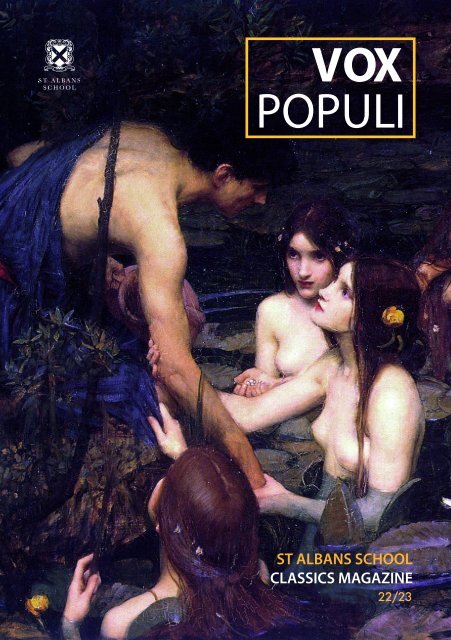Create successful ePaper yourself
Turn your PDF publications into a flip-book with our unique Google optimized e-Paper software.
VOX<br />
POPULI<br />
ST ALBANS SCHOOL<br />
CLASSICS MAGAZINE<br />
22/23
Contents<br />
5 Editoral<br />
6 The Twelve Tables<br />
9 Ancient Medicine<br />
10 Cleopatra<br />
11 Gladiators<br />
12 Solon<br />
15 Women in Greek Mythology<br />
16 British Museum<br />
17 Roman Legal Procedure<br />
19 Xenophanes<br />
21 Composing Epic Poetry<br />
22 The Art of the Simile<br />
23 The Gallery<br />
24 Capital Punishment<br />
26 Moot Trial of Alexander the Great<br />
28 Life of Cicero<br />
30 Philology<br />
32 Dido<br />
2 3
Editorial<br />
Jonathan, Lower Sixth<br />
Our theme for this edition of vox<br />
populi is ‘panem et circenses,’<br />
the concept of ‘bread and<br />
games’ for the people, to<br />
reflect our desire to provide something for<br />
everyone’s taste in our magazine through<br />
its variety and depth of scholarship.<br />
As the field of Classics develops, so its<br />
boundaries widen to become ever more<br />
diverse in its scope. With that in mind,<br />
we have maintained our commitment to<br />
some of the more traditional philological<br />
aspects of the subject, but we have also<br />
considered how Classics is furthering the<br />
way it defines itself, spatially, temporally<br />
and at points of connectivity with other<br />
related academic disciplines and cultures<br />
as we look to the future. After all, we are<br />
at our strongest when we work together.<br />
The Classics Department and the<br />
Hylocomian Society have enjoyed a<br />
wealth of co-curricular experiences<br />
this year. Lower School students have<br />
visited part of the furthest reaches of the<br />
Roman Empire with their expedition to<br />
Hadrian’s Wall. As we have developed<br />
our scholarship beyond the curriculum,<br />
our Hylocomian Society lectures have<br />
been stimulating and challenging,<br />
considering questions from the nature<br />
of God to the very roots of Greek, Latin<br />
and our own languages. Enhancing our<br />
specialist knowledge further through<br />
the Sixth Form’s regular Symposium,<br />
students have collaborated on themes<br />
which stretch from archaic Greek history<br />
to later portrayals of one of the most<br />
powerful women in literature, Dido,<br />
Queen of Carthage. We are delighted to<br />
share our explorations with you.<br />
It only remains for me to thank all<br />
those involved in the production of this<br />
issue of vox populi. First, I would like<br />
to thank all the students and staff who<br />
have contributed articles and those who<br />
have kept us all thinking and reflecting<br />
on the ancient world through their<br />
enthusiasm and curiosity. The questions<br />
we have been asked on our Classical<br />
journey have resulted in more interesting<br />
answers. Second, thanks must be offered<br />
to my fellow student editors in the<br />
Lower Sixth Form, whose perspectives<br />
and contributions have been greatly<br />
appreciated. Finally, I would like to extend<br />
special thanks to Mrs Ginsburg, Head of<br />
Classics, for her tireless enthusiasm and<br />
support in developing this publication;<br />
her guidance and expertise have proved<br />
invaluable to us all.<br />
Opposite: The Romans of the Decadence - Thomas Couture<br />
4 5
The Twelve Tables<br />
Xavi, Lower Sixth<br />
After the last king of Rome had<br />
been expelled from Rome, the<br />
new republic was governed by<br />
a system of hierarchy between<br />
magistrates. However, only those who<br />
were part of the patrician class – an early<br />
Roman aristocracy comprised of ruling<br />
class families – were able to become<br />
magistrates. This was among other<br />
factors that led to great dissatisfaction<br />
amidst the plebian class who felt that<br />
they were unrepresented and at risk of<br />
being subject to tyranny of a higher class<br />
who had complete control of the law and<br />
its interpretation. This social struggle<br />
between classes is called the Conflict of<br />
the Orders and lasted roughly 200 years;<br />
the plebians effectively held the upper<br />
hand within the struggle as they could<br />
hold Rome ‘hostage’ by threatening to<br />
leave the city so that it would come to a<br />
standstill because the plebians were the<br />
city’s labour force. The Twelve Tables<br />
are a consequence of plebians insisting<br />
that the previously unwritten customs<br />
from which law in Rome was derived<br />
be codified. The Twelve Tables were not<br />
a reform but instead a way for regular<br />
Roman citizens, beyond the previous<br />
model which involved only a handful<br />
of specialised magistrates being familiar<br />
with the law, to know their rights as well<br />
as the Tables acting as a safeguard from<br />
tyranny.<br />
Following increased pressure from<br />
Roman plebians in the 450s BC, a<br />
committee called the ‘decemviri’ (literally<br />
translating After the last king of Rome<br />
had been expelled from Rome, the new<br />
republic was governed by a system of<br />
hierarchy between magistrates. However,<br />
only those who were part of the patrician<br />
class – an early Roman aristocracy<br />
comprised of ruling class families – were<br />
able to become magistrates. This was<br />
among other factors that led to great<br />
dissatisfaction amidst the plebian class<br />
who felt that they were unrepresented<br />
and at risk of being subject to tyranny of a<br />
higher class who had complete control of<br />
the law and its interpretation. This social<br />
struggle between classes is called the<br />
Conflict of the Orders and lasted roughly<br />
200 years; the plebians effectively held the<br />
upper hand within the struggle as they<br />
to ten men) was established and sent to<br />
Greece in order to study the legal system<br />
of Athens and other Greek civilisations.<br />
The first committee completed the first<br />
ten codes of the eventual twelve in 450BC<br />
and a year later a second committee of ten<br />
men completed two more codes after a<br />
‘secessio plebis’ (secession of the plebes)<br />
compelled the Senate to consider them.<br />
After the last two codes were finished –<br />
the twelve tables were finally declared<br />
law.<br />
The Twelve Tables was the first legal<br />
document codifying the rights that each<br />
and every Roman citizen had – these<br />
tables were comprised of ‘unwritten laws’<br />
that were already an established norm in<br />
Roman culture. The provisions set out<br />
by the Twelve Tables recognised legal<br />
conventions that are now commonplace<br />
in modern legal systems around the<br />
work; these included equal rights for all<br />
citizens to a fair trial by due process, laws<br />
surrounding slander and defamation,<br />
and differentiation between murder and<br />
manslaughter.<br />
The first three tables explore the rights of<br />
citizens concerning trials, due processes in<br />
court and how the judgement of the court<br />
could be exacted. The first table discusses<br />
proceedings between the plaintiff and<br />
defendant; it considers how the court<br />
should respond to various circumstances<br />
such as what to do if the defendant fails to<br />
appear in court or age/sickness prevents<br />
them from doing so. An unusual feature<br />
of this table for modern readers would<br />
be the principle that if either one of the<br />
parties failed to appear at the trial, then<br />
the judge would make their judgement<br />
in favour of the present party no matter<br />
the circumstances. This also formed a<br />
system of timetabling for the trial, as it<br />
was decreed that all trials would end at<br />
sunset. The second table talks further<br />
Above: Appius Claudius Caecus in Senate - Cesare Maccari<br />
about court proceedings – it states that if a<br />
witness failed to show up, then the party<br />
who summoned them could shout and<br />
scream in front of his house every three<br />
days. This table also states that a slave<br />
who committed theft should be flogged<br />
and then thrown to their death off of the<br />
Capitoline Hill cliff.<br />
The third table is most notable for dictating<br />
how to deal with defrauding and areas<br />
surrounding credit. Table III declares that<br />
after 30 days of the debt being unpaid,<br />
then the debtor would be brought to court<br />
by force and the court would then hand<br />
the debtor to the creditor for a period of<br />
up to 60 days, which would most likely<br />
be for labour. The conditions on which<br />
the debtor should be held are also set out<br />
and after the term of 60 days, the debtor<br />
could in some circumstances be sold into<br />
slavery.<br />
The fourth table sets out the rights of<br />
the ‘paterfamilias’ (the patriarch of the<br />
family) which specifically apply to him.<br />
This part of the code contains disturbing<br />
proclamations such as that “dreadfully<br />
deformed” children should be quickly<br />
euthanised by the father and that if a<br />
father tries to sell his son three times, then<br />
the son will automatically become free.<br />
This section also dictates that sons are<br />
born into the inheritance of their family<br />
and that if a boy is born within 10 months<br />
of their suspected father’s death then they<br />
are entitled to the man’s inheritance.<br />
Tables V, VI and X discuss estates,<br />
possession and religion and therefore<br />
largely pertain to women as women at<br />
the time were seen as possessions, which<br />
is evident from the laws surrounding<br />
ownership. Table five is concerned with<br />
guardianship and the wills of citizens;<br />
any inheritance was automatically given<br />
to a man’s sons, however, if he had no<br />
6 7
sons then it would be given to his nearest<br />
male relative. However, if the man had<br />
no living male relatives, members of his<br />
extended family would become the heirs<br />
to the inheritance. Women were also<br />
forced to remain under the guardianship<br />
of a man, whether it was their husband<br />
or father, no matter how old they were<br />
(the notable exception to this were the<br />
Vestal Virgins. The sixth table states<br />
that a woman who lived with a man for<br />
one year was his by marriage – and to<br />
avoid this would have to be away from<br />
his house for three consecutive nights<br />
each year. This table also discusses the<br />
freedom of slaves and how to go about<br />
it – if there was an argument concerning<br />
two conflicting claims over a slave’s<br />
freedom, then the judge would have to<br />
rule in favour of freeing the slave if there<br />
was a lack of evidence. The tenth table –<br />
concerned with religion and rites – stated<br />
that women should not wail nor scratch<br />
their faces when they were mourning<br />
and that no more than three women<br />
were permitted to prepare a corpse for a<br />
funeral. The manner in which cremations<br />
took place was also set out – jewellery<br />
was not allowed to be cremated and<br />
pyres could not be built from expensive,<br />
polished woods.<br />
Tables seven and eight cover areas of what<br />
modern legal systems would call tort<br />
law, as well as covering land rights. The<br />
seventh table declared that all roads were<br />
to be eight feet wide and that the people<br />
who live near it were responsible for its<br />
upkeep. Table VIII sets the precedent that<br />
one who causes another damage should<br />
pay the victim double the value of the<br />
damaged property – if the perpetrator<br />
was a child, then the victim could decide<br />
whether or not to flog them. The most<br />
startling convention set out in this section<br />
was a death penalty for slander – the<br />
guilty party was to be put to death by<br />
clubbing.<br />
The eight table also deals with the crime<br />
of killing, intentional and unintentional,<br />
and the circumstances of the specific<br />
murder who determine what punishment<br />
was to be given (patricide, for example,<br />
was treated differently to homicide). The<br />
penalty for accidentally causing one’s<br />
death was to appease the victim’s family<br />
by offering a ram for a public sacrifice.<br />
Murder was obviously punishable by<br />
death; yet patricide was viewed as the<br />
worst possible crime. Someone found<br />
guilty of patricide was to be sewn into a<br />
leather sack containing a dog, a viper, and<br />
a cockerel and then flung into a river.<br />
Table IX sets out the concept adopted by<br />
countries around the world that everyone<br />
is equal in the eyes of the law. This table<br />
also decrees that death sentences were<br />
only allowed to be given by a court of<br />
law and these verdicts could be appeal in<br />
some cases.<br />
The last two tables (XI & XII)<br />
supplemented the other ten tables –<br />
however the eleventh table that forbid<br />
marriage between the plebeian and<br />
patrician classes was repealed shortly<br />
after being introduced. The twelfth and<br />
final table clarifies certain aspects of the<br />
other tables – it sets out a distinguishment<br />
between intentional and accidental<br />
killing.<br />
Ancient Medicine<br />
Subechya, Lower Sixth<br />
The ancient world believed that the gods<br />
were the reason why they got sick, as<br />
they were often held responsible for good<br />
health. The ancients believed that if they<br />
angered the gods this could cause them to<br />
fall ill.<br />
Above: The Temple of Asclepius at Villa Borghese in Rome -<br />
Anonymous<br />
The earliest doctor is claimed to be<br />
Asclepius; yet, many question whether<br />
he truly even existed. Many did however<br />
believe in his existence due to his Temple<br />
in Rome and Sanctuary at Epidauras<br />
where ‘no patient ever died’, this being<br />
because anyone on the verge of death<br />
was denied admittance and existing<br />
patients with worsening conditions were<br />
abandoned in the forest by priests.<br />
Matters changed with the arrival of<br />
Hippocrates, the first to discredit that<br />
the magical cures and promote belief<br />
in the study of the human body and<br />
experimental research.<br />
8 9<br />
Some ancient medical practices include<br />
trepanning, use of animal dung as a<br />
beauty balm and as an elixir of human<br />
flesh, bone and blood to cure headaches,<br />
as well as muscle cramps and stomach<br />
ulcers.<br />
Women were not spared from the<br />
patriarchal society, even with regards to<br />
medicine and because they were viewed<br />
as filth, they thought that there was no<br />
other suitable cure for them other than<br />
filth.<br />
Despite this, the main cure for the most<br />
common ailments experienced by women<br />
was thought to be sex and pregnancy.<br />
They believed that when a woman did<br />
not have intercourse, her womb became<br />
dry and was liable to become displaced,<br />
a condition known as hysteria (from the<br />
Greek hystēr ‘womb’).<br />
Therefore, the ancient medical practice<br />
made some fatal errors, yet they have<br />
provided the basis for the principles<br />
which we have since developed.<br />
Above: Alexander of Macedon trust the doctor Philip - Henryk<br />
Siemiradski
Cleopatra<br />
Parth, Second Form<br />
My symposium was done on Cleopatra’s<br />
supposed suicide, and whether she did<br />
kill herself be getting her maids to sneak<br />
in a fig basket with a snake in. After all<br />
Octavian, being a typical Roman emperor,<br />
was a twisted psychopath, and if he did<br />
want to kill Cleopatra, he’d tell everyone<br />
it was suicide.<br />
After all, the snake that killed her was<br />
called an aspis, which, depending on the<br />
language, could mean a Saharan Sand<br />
Viper, or an Egyptian Cobra – the first has<br />
weak venom that can’t kill you, and the<br />
second is too big to be smuggled in in a fig<br />
basket, and the venom is only discharged<br />
50% of the time, and the maids committed<br />
suicide after Cleopatra (Or did they –<br />
maybe they were killed as witnesses)<br />
Talking about the fig basket – the biggest<br />
Egyptian baskets were not big enough to<br />
hold a snake. Trust me, I spent a full hour<br />
on the Le Louvre website trying to search<br />
up basket before realising it was a French<br />
website, and then I searched up French for<br />
basket, and all it gave me was the wrong<br />
thing. French for basket was panier!<br />
The Psylli were a tribe – now extinct – of<br />
nomads. The Romans claimed they can<br />
heal snakebites. That sounds plausible,<br />
right? The Romans also claimed they<br />
were immune to poison. Okay, maybe it<br />
could be true? They had no females. Still<br />
slightly plausible? They also went extinct<br />
600 years before Octavian lived.<br />
Whether the Psylli existed or not, Octavian<br />
said he marched in with the Psylli just<br />
after Cleopatra committed suicide –<br />
even though it would take 4-5 days to<br />
take them there, even on horseback! Did<br />
he know Cleopatra was going to die of<br />
poison.<br />
The snake was never found in the room.<br />
Also, how did the maids catch the asp?<br />
One major thing to consider is that<br />
the same way we have biases around<br />
countries, the Romans thought that Egypt<br />
was full of snakes, the same way we<br />
think all Italians eat pizzas (pizza is made<br />
mainly for tourists).<br />
Also, Egyptians think there is only<br />
one way to commit suicide without<br />
having yourself being eaten by Ammit<br />
the Devourer – to jump into the river<br />
Nile (which would turn you immortal).<br />
Romans, however, thought that suicide<br />
was a Roman way of death, so it would<br />
make sense to Octavian that Cleopatra<br />
would commit suicide, but not to the<br />
Egyptians!<br />
Gladiators<br />
Will, Third Form<br />
On the 16th of January, St Albans School<br />
was visited by author Ben Kane. One<br />
particularly interesting part of the<br />
workshop was the Roman Gladiator<br />
Fact or Myth Section where Ben Kane<br />
myth busted common myths regarding<br />
gladiators.<br />
Some surprising myths came up like the<br />
fact that all gladiators did not fight to<br />
the death. This rattled our perception of<br />
gladiatorial fights.<br />
We were also informed of the fact that<br />
gladiators were not terribly muscular.<br />
Many TV shows and movies portray<br />
gladiators to be muscular and fit but<br />
Opposite: The Meeting of Antony and Cleopatra - Sir<br />
Lawrence Alma-Tadema<br />
Below: Ave Caesar! Morituri te salutant - Jean Léon Gérôme<br />
scientific evidence proves this to be false.<br />
Ben Kane explained to us that muscular<br />
people who got injured are more likely<br />
to be unable to fight since their skin is<br />
thin. More obese people could get cut<br />
and since their skin is thick they would<br />
not be properly injured. This led to the<br />
conclusion that more obese people could<br />
survive longer in gladiatorial games. This<br />
was fascinating to understand. Ben Kane<br />
showed us the bridge between history<br />
and science.<br />
Modern artwork does not accurately<br />
depict the true nature of gladiatorial<br />
games. One painting that the author<br />
showed us described a naval battle taking<br />
place in an arena. We were showed by<br />
Ben Kane that this is actually wrong. He<br />
explained that arenas could not hold that<br />
much water and that many ships due to<br />
its size.<br />
I thoroughly enjoyed the experience and<br />
hope to have many more.<br />
10 11
Solon: Reformer,<br />
Law Maker, Poet<br />
Jonathan, Lower Sixth<br />
The principal sources for<br />
details of Solon’s life are<br />
Herodotus and Plutarch,<br />
with Aristotle providing<br />
information on changes in<br />
the field of law.<br />
Who was Solon?<br />
Solon was an Athenian politician and poet<br />
of noble birth who lived in the late seventh<br />
and early sixth centuries BCE. One of the<br />
Seven Sages listed in Plato’s Protagoras,<br />
he was archon at Athens 594-593 BCE.<br />
This is probably when he put in place<br />
his reforms, which modernised Dracon’s<br />
earlier laws. Despite his noble birth, he<br />
came to sympathise with the poor. After<br />
his archonship, he left Athens to travel<br />
for 10 years, with this being the period<br />
of time within which the Athenians had<br />
agreed not to change his laws in order for<br />
them to have time to take effect.<br />
Why is Solon an important figure in<br />
ancient Greek history?<br />
Through his changes and legislation, Solon<br />
laid the foundations for the reasonably<br />
stable society of democratic Athens. His<br />
reforms strengthened the assembly and<br />
the law courts. Furthermore, he made<br />
changes to society which created a free<br />
peasant class and curbed the powers of<br />
the nobility to some extent. Indeed, he<br />
Below: Solon - Merry Joseph Blondel<br />
can be considered an early agent in social<br />
class struggle, if we wish to use a rather<br />
anachronistic term.<br />
Arguably, Solon’s most important reform<br />
was ‘seisachtheia’ (literally a ‘shaking off<br />
of burdens’), which is sometimes seen as<br />
a cancellation of debts. It is more likely<br />
to have been a liberation of the class of<br />
‘hektemeroi’ (sixth parters) who gave<br />
a sixth of their produce to an overlord.<br />
This was abolished and they became<br />
absolute owners of their land. However,<br />
Solon did introduce changes to limit the<br />
social impact of debt. Specifically, men<br />
enslaved for debt were freed and it was<br />
no longer legal to enslave someone on<br />
these grounds.<br />
The commercial environment at Athens<br />
the commercial growth of olives for trade.<br />
This reform also yielded social benefits<br />
since it kept an affordable food supply at<br />
home.<br />
How did he organise the Athenian<br />
citizens and what was the political<br />
impact?<br />
Solon categorised the people of Athens into<br />
four property classes, which undermined<br />
the power of noble families where political<br />
influence was hereditary. The four classes<br />
were the Pentakosiomedimoi (who<br />
owned property to yield 500 medimnoi<br />
at least), the Hippeis (generally cavalry<br />
when required), the Zeugetai (whose<br />
land yielded 200-300 medimnoi)and the<br />
Thetes (lowest of four property classes).<br />
The two higher classes held the major<br />
political offices while the zeugetai<br />
were eligible for minor offices. Thetes<br />
were permitted to attend the assembly<br />
(ekklesia) and the law court (Eliaia). It<br />
is also possible that Solon incorporated<br />
allotment to the election of archons and<br />
he probably created a new council of 400<br />
to prepare business for the assembly.<br />
What was the nature of Solon’s<br />
legislation?<br />
The evidence we have for Solon’s<br />
legislation suggests an emphasis on<br />
social cohesion. In the area of family law,<br />
orphaned heiresses did not enter their<br />
husband’s family but were to produce<br />
heirs for their own family, and those who<br />
did not have heirs were able to adopt a man<br />
to be heir under certain conditions. There<br />
was a moral element to the legislation<br />
since there were punishments for a lack<br />
of chastity in women, as there were for<br />
the procurement and prostitution of<br />
boys, and a further law against excessive<br />
display at funerals. Moreover, theft was<br />
harshly punished if in the dark or from a<br />
public place such as a market.<br />
What do we know about Solon as a poet?<br />
Unfortunately, Solon’s poetry only exists<br />
in fragments. It appears to be focused on<br />
his reforms and is rather moralising in<br />
tone. Examples include:<br />
Laws I wrote alike for nobleman and<br />
commoner, awarding straight justice to<br />
everybody. (24.18)<br />
To the demos I have given such honour as<br />
seems sufficient, neither taking away nor<br />
granting them more. For those who had<br />
power and were great in riches, I equally<br />
cared that they should suffer nothing<br />
wrong. Thus, I stood holding my strong<br />
shield over both, and I did not allow<br />
either to prevail against justice. (5.1ff)<br />
(Translation by Eherenberg)<br />
What does Herodotus tell us about him?<br />
The fifth century (BCE) historian,<br />
Herodotus, tells us that, during his ten<br />
years of travelling after implementing his<br />
reforms, Solon arrived in Sardis, the major<br />
city of Lydia, where he met King Croesus.<br />
Croesus asked him whom he considered<br />
to the happiest of men, to which Solon<br />
replied an Athenian called Tellus, who<br />
had sons, all of whom had surviving<br />
children. Tellus fought for Athens, died<br />
in battle and had a glorious death. As a<br />
result, he was honoured with a public<br />
funeral. Solon would not even agree<br />
that Croesus was the second happiest<br />
person, instead citing two Argive young<br />
men who dragged their mother’s cart to<br />
12 13
Women in Greek Mythology<br />
Izzy, Lower Sixth<br />
Medusa was a woman who<br />
had snakes instead of hair<br />
and turned men to stone<br />
when they looked her in<br />
the eye. She lived in a cave with her two<br />
sisters, Stheno and Euryale, and they<br />
were collectively known as the Gorgons.<br />
Many people over time have villainised<br />
Medusa and turned her into a monster<br />
when, in reality, she was mostly innocent.<br />
nobody labels him as evil or twisted.<br />
I also talked about other women such<br />
as Medea, the witch queen of Corinth,<br />
Pandora, the first mortal woman, and<br />
Circe, the sorceress of Aeaea, who I feel<br />
are similarly unjustly represented in<br />
Greek mythology.<br />
Hera’s temple, ensuring their reputation,<br />
then died peacefully in the temple. His<br />
point was that no man can be considered<br />
happy until he is dead since he does not<br />
know what lies ahead. Croesus only<br />
understood the wisdom of Solon’s words<br />
when he had lost his kingdom to the King<br />
of Persia, Cyrus, and was imprisoned.<br />
HOW SHOULD WE EVALUATE SOLON?<br />
Was Solon a revolutionary?<br />
The evidence suggests that he was an<br />
agent of class change but not radical.<br />
Did his changes last?<br />
They were broadly sustained. His laws<br />
were lasting but social factionalism broke<br />
out. Some Athenians blamed Solon for not<br />
becoming a tyrant and, in fact, Peisistratus<br />
later became a tyrant at Athens.<br />
What was his legacy?<br />
His most significant contribution to the<br />
development of Athenian politics was<br />
that he paved the way for Cleisthenes’<br />
democratic reforms at Athens in the<br />
later sixth century BCE. And, of course,<br />
even then, women and slaves were still<br />
excluded from political power.<br />
Above: Croesus and Solon<br />
Medusa was born a very beautiful human,<br />
so beautiful that the god Poseidon took<br />
interest in her, resulting in him forcing<br />
himself on her inside Athena’s temple<br />
where Medusa ran hoping for protection<br />
from the goddess. From this event,<br />
Athena cursed Medusa turning her hair<br />
into snakes so she was no longer attractive<br />
and cursing her sight so she could never<br />
be with a man again. It has been argued,<br />
however, that this was done so nobody<br />
could take advantage of her again and<br />
Athena was giving her a way to protect<br />
herself.<br />
People also make her out to be a coldhearted<br />
beast because she turns men into<br />
stone, however, she did more damage in<br />
death than in life as there are little to no<br />
tales of her maliciously turning people<br />
to stone yet her decapitated head was<br />
Perseus’ favourite weapon. Her face was<br />
even put on the Aegis which was a shield<br />
Athena carried in battle.<br />
Medusa is also unfairly portrayed partly<br />
down to her gender as there are other<br />
examples of characters such as Midas<br />
who, at his request, was “blessed” with<br />
the gift of turning objects into gold but<br />
Below: Perseus, under the protection_of_Minerva, turns<br />
Phineus to stone by brandishing the head of Medusa<br />
14 15
British Museum<br />
Johan, Third Form<br />
Roman Legal Procedure<br />
Xavi, Lower Sixth<br />
On Monday 6th January, the classics<br />
department and students went on a trip,<br />
visiting the British Museum. Upon arrival,<br />
we first got to explore the fascinating<br />
hieroglyphics exhibition, featuring the<br />
world-famous Rosetta Stone. The Rosetta<br />
Stone was a relatively insignificant<br />
proclamation from King Ptolemy V, but<br />
was inscribed in 3 different languages,<br />
demotic, hieroglyphic and Greek<br />
allowing experts to translate demotic<br />
and hieroglyphic. It was very interesting<br />
to learn about the history of the Rosetta<br />
Stone and how it made its way from<br />
Egypt to the British Museum after being<br />
discovered by the French. We got to see<br />
the wide variety of different hieroglyphics<br />
and how they could form new words in<br />
different combinations. There are in total<br />
over 700 hieroglyphics, many of which<br />
were difficult to tell apart, making it a<br />
very difficult language to decipher.<br />
There were also lots of Egyptian statues to<br />
see, which were impressively carved out<br />
of stone. Many of them were Sphynxes<br />
with lion’s hindquarters. Afterwards,<br />
we were able to explore the museum<br />
independently, which allowed us to<br />
explore our own historical interests. I<br />
personally really enjoyed visiting the<br />
medicine display that explores the<br />
thousands of drugs and pills that an<br />
average British person takes in a lifetime.<br />
I was shocked to find out how many<br />
pills people on average end up taking<br />
throughout their lives. This exhibition<br />
also provides a fascinating opportunity<br />
to appreciate the wonders of modern<br />
medicine that have so greatly improved<br />
our lives. Finally, we had time to browse<br />
the gift shop in order to find things with<br />
which to remember our trip by.<br />
Below: The Sphinx<br />
The legal procedure that Rome<br />
used in its courts evolved<br />
throughout the lifetime of the<br />
Republic and then Empire; the<br />
foundations that the Romans laid for<br />
legal method have been used as the base<br />
for the legal systems for the majority of<br />
European countries and others around<br />
the world. The development of the<br />
system was shaped by three major events:<br />
the ‘legis actiones’, the ‘formulary system’<br />
and the ‘cognitio extraordinaria’ which<br />
was in use after the fall of Rome.<br />
The ’legis actiones’ were formulated<br />
around the same time as the Twelves<br />
Tables of Roman law in the fifth century<br />
BC – these acts divided the court<br />
proceedings into several steps. A plaintiff<br />
would first have to address the defendant<br />
in a public forum and request them to<br />
go to court; however, if the defendant<br />
refused to go to court, they would be<br />
taken there by force. Each case that was<br />
taken to court was separated into two<br />
parts, the first of which was primarily<br />
a formality where a magistrate would<br />
decide whether there was a good case for<br />
a trial and, if there was, they would set out<br />
the specifics of the issue. Once the issues<br />
at hand had been defined, a ‘iudex’ who<br />
was a sort of legal layman as opposed to<br />
a barrister or magistrate would be chosen<br />
by both the plaintiff and defendant. The<br />
second part of the trial would happen<br />
under the supervision of this iudex,<br />
this stage was less formal than the first<br />
and it was here that witnesses would be<br />
called to the stand, evidence set out and<br />
barristers would make their arguments.<br />
However, the verdict that the iudex came<br />
to was simply advisory and they did not<br />
have the power to execute the decision;<br />
unlike modern judicial systems, the party<br />
which won the trial was responsible for<br />
enforcing the judge’s verdict themselves.<br />
If the losing party refused to pay the<br />
penalty, then the court was allowed<br />
to bring them back by force and pay a<br />
heftier penalty. This heightened penalty<br />
depended on the nature of the original<br />
trial – if the case involved debt, then the<br />
debtor’s assets could seized or they could<br />
be given as a slave to the plaintiff until<br />
the debt was paid off. The alternative was<br />
to sell them into slavery or to have them<br />
dismembered.<br />
As Roman society evolved, the cases that<br />
came to the courts grew more complex<br />
and in turn the judicial system advanced.<br />
The new formulary system was created to<br />
replace the overly formal and traditional<br />
‘legis actionis’ system; its roots were<br />
found in the way in which praetors dealt<br />
with foreigners, but it was deemed so<br />
effective that its use was adopted into<br />
regular Roman law. These reforms meant<br />
that the process was more streamlined as<br />
well as the proceedings now being written<br />
down. The pre-existing custom of calling<br />
the defendant to court remained, but now<br />
the plaintiff could physically drag the<br />
defendant to court. The formulary system<br />
got its name from the formula used in<br />
the preliminary hearing comprised of six<br />
stages: nominatio, intentio, condemnatio,<br />
demonstratio, exceptio, and praescriptio.<br />
The main difference between trials under<br />
the formulary system and those of modern<br />
16 17
systems is that the case could occasionally<br />
be resolved in the preliminary hearing via<br />
the taking of oaths. Taking an oath to the<br />
gods was seen as a deeply serious matter<br />
and very few people would be willing to<br />
perjure themselves (the penalty for perjury<br />
was grave in both the eyes of the law<br />
and the gods). The plaintiff could throw<br />
the gauntlet to the defendant by making<br />
him swear an oath – if the defendant was<br />
willing to take this oath, then he won, but<br />
if he did not, then he lost. This could be<br />
reversed for the plaintiff where the same<br />
rules would apply.<br />
If the trial progressed beyond the<br />
preliminary hearing, it would play out in<br />
the same way as under the ‘legis actionis’<br />
system. In the case of the debt, a new<br />
procedure of holding a public auction<br />
of the possessions of the debtor’s estate<br />
would help the creditor to be reimbursed.<br />
The third and final major development<br />
in the procedure of the Roman judicial<br />
process was the introduction of the<br />
‘cognitio extraordinaria’ system. This<br />
system was introduced after the Roman<br />
Empire succeeded the Republic and bears<br />
the most similarity with modern justice<br />
structures. For the first time, defendants<br />
were summoned to the court by the court<br />
instead of the plaintiff having to summon<br />
them; plaintiffs had to file a statement of<br />
claim. If either one of the parties failed to<br />
show at court on the date three separate<br />
times then the party which turned up<br />
won by default. The other major change<br />
that the cognito system brought was the<br />
process of appeals – the case could in<br />
theory progress up through higher courts<br />
and potentially reach the emperor.<br />
Although law predates Rome by<br />
thousands of years through social<br />
convention and speech, Romans<br />
revolutionised the way in which the rule<br />
of law was implemented. It created a<br />
blueprint for the societies that followed<br />
through its systematic and impartial<br />
process; while none of the punishment<br />
have stood the test of time, the way in<br />
which the law is applied remains largely<br />
the same.<br />
Below: Roman Law<br />
Xenophanes<br />
Jonathan, Lower Sixth<br />
In the Autumn term Dr Shaul Tor, Senior<br />
Lecturer in Ancient Philosophy at King’s<br />
College London, delivered an insightful<br />
lecture on the philosophy of Xenophanes<br />
to the Hylocomian Society. His theme<br />
was: What if cows could draw Gods?<br />
And what do we see in a rainbow? Some<br />
philosophical questions in Xenophanes.<br />
Dr Tor began with an exploration of<br />
Xenophanes’ biography. The Presocratic<br />
philosopher was active in Colophon<br />
(in Ionia) at the end of the sixth and<br />
beginning of the fifth century BCE. He<br />
travelled widely around Greece and<br />
wrote in verse, using both the hexameter<br />
and elegiac form. Xenophanes’ interests<br />
lay in theology, knowledge and belief,<br />
natural philosophy, ethics and politics.<br />
His work remains either in fragmentary<br />
form or preserved in the works of other<br />
writers such as Aristotle and Plutarch.<br />
Dr Tor then proceeded to reveal how<br />
the fragmentary evidence we have for<br />
Xenophanes’ work can be worked into a<br />
coherent picture of his stated perspective<br />
on the nature of the gods. By way of<br />
context it is important to consider the<br />
fact that the ancient Greek literary canon<br />
drew heavily on Homer’s epics, The<br />
Iliad and The Odyssey, and Hesiod’s<br />
poetry about the origins of the gods,<br />
Theogony. Both writers feature multiple,<br />
anthropomorphic, imperfect deities.<br />
However, fragments of Xenophanes’<br />
work show him noting mortal belief that<br />
gods are born and have bodily form and<br />
clothing similar to their own.<br />
He further notes that the poets portray<br />
the gods as committing acts which are<br />
reprehensible for mortals, for example<br />
theft, adultery and deceit. Aristotle’s<br />
18 19<br />
capture of Xenophanes’ philosophy<br />
suggests that he considered it to be<br />
impious to suggest that gods came into<br />
being or die. Furthermore, Xenophanes’<br />
fragments draw out his suggestion that<br />
all people create god in their own image;<br />
he suggests that the Thracians and<br />
Ethiopians, who tend to look physically<br />
very different, say that their gods look<br />
like them and, if they could draw, horses<br />
would render images of their gods to look<br />
like horse and oxen to look like oxen.<br />
What is particularly interesting in the<br />
further fragments is the similarity<br />
of Xenophanes’ philosophy to a<br />
monotheistic system. Although his<br />
assertion of “One god, greatest among<br />
gods and men,” does not exclude<br />
polytheism, his assertion of this being<br />
as “not at all like mortals either in frame<br />
or cognition” implies an unknowable<br />
quality in a supreme god. Moreover,<br />
he also alludes to an omniscience and<br />
omnipotence in this supreme god. This<br />
being is further located as unchangeable<br />
in space and time. These fragments have<br />
remarkable resonance in modern religion.<br />
Xenophanes is no less critical of the minor<br />
deities, often deployed by ancient writers<br />
to explain natural phenomena. In a further<br />
fragment, he critiques the goddess Iris,<br />
who manifests as a rainbow, believing her<br />
to be “by nature cloud, purple, and red,<br />
and greenish-yellow to behold.” This is<br />
a marked step away from the Olympian<br />
pantheon and their attendant demi-gods<br />
and goddesses, who cause thunder,<br />
storms, and the changing of the seasons.<br />
In short, Dr Tor left us with the impression<br />
of a very modern mind forged in an<br />
ancient context and much to consider<br />
to explore further the philosophy of the<br />
Presocratics.
Composing Epic Poetry<br />
John-Ellis, Lower Sixth<br />
from ἡ Οὐλσινεία: Ulsinea (v. 136-150)<br />
σίγησεν δ’ αὖ Γαβριήλ· μᾶλλον δ’ ἀνά χεῖρας<br />
But Gabriel was silent in response; rather, he lifted up his hands<br />
κρούσεν ἄγων, παράδειγμα δ’ ἔτριψεν ἐς οὔτι οὗ ἧκεν.<br />
and clapped, and the paradigm crumbled into the naught whence it came.<br />
Γαβριήλ δὲ κρινοστέφανος στῆθος μεγαλαύχει<br />
And Gabriel of the lily garland began to boast his chest,<br />
δῖον ὁρᾶν· αὔξῃ ὠλενῶν πόδε γυμνώ ἀνεῖχον.<br />
godly to behold; with the expanse of his arms, his unshod feet began to arise.<br />
κρᾶτ’ ἀνέκυψε κόμην δ’ ἀγαπηθεῖσαν καθέηκεν<br />
He tilted back his head and let down his pampered hair<br />
λουθεῖσάν τ’ Ἐδὲμ ὑδρηλῇ ὑγρήν τε ἀλοιφῇ<br />
which had been bathed in watery Eden and was moist with ointment<br />
Σουμερίης τετραρειθρώδευς πολυχρύσου Εὐιλάτ.<br />
from Sumer of the four bounding streams and Havilah, rich in gold;<br />
ἠΰτε πέρ ῥεθομαλίδας οὔπω ὀπωρῃ ἔτ’ Εὔα<br />
just as when apple-cheeked Eve, still not yet in any way tainted by the fruit,<br />
κως μυσαρή, ἐκ Σόλλακος εἶσ’ ἐπί ἀνέρι καλή,<br />
cometh forth from the Sollax as a beauty for her husband,<br />
οἷ δὲ δίδωσιν ἔλαιον ἑκών μενοεικέσι χερσίν,<br />
and he willingly offers her olive oil with his agreeable hands,<br />
ὄφρα φέρῃ κτένα βωλοκόπον βλοσυρῆς διά χαίτης<br />
that she may lead her clod-breaking comb through her shaggy mane,<br />
ᾄσσομένης μελανοπλοκάμου λείῳ κατά νώτῳ.<br />
which flutters in black tresses down her smooth back.<br />
ἐσθλή ἐπόψει Εὔα ποιητῶ παντετοκυῖα,<br />
And Eve, mother of all, is good in the sight of her Maker,<br />
εὐώδης θρέμμασσιν, ἅ ἦρος ἀνεῖκε χίμαιρα·<br />
sweet to the smell of nurslings, whom the nanny-goat hath borne in the spring;<br />
καὶ ὥς ἐν ὕπνῳ Γαβριήλ ᾐωρέετ’ αἰπύς.<br />
even so was Gabriel suspended, lofty in trance.<br />
20 21
The Art of Simile<br />
John-Ellis, Lower Sixth<br />
One of the most integral constructs of the<br />
Homeric tradition is the simile – or, in<br />
Greek, παραβολή (parabolē, from which<br />
we gain the English ‘parable’). When one<br />
writes in the style of Homer, the objective<br />
is not simply to acquire a grasp for the<br />
Epic dialect, nor to develop a mastery<br />
of dactylic hexameter; rather, one must<br />
begin to understand Homer’s literary<br />
flair.<br />
Homer’s timeless success as a poet may<br />
be easily pinned down to his unparalleled<br />
artistry in storytelling, leading to the<br />
popularity of his works more than 2800<br />
years later. Scholars on all sides of the<br />
Homeric Question hold the central facets<br />
of the genre in great respect: the simile,<br />
the metaphor, intertextuality etc. Notably,<br />
however, these all come on much grander<br />
and more elaborate scales than one might<br />
typically find in English literature. For<br />
Homer, the simile is a device of visionary<br />
transportation: the pylon through which<br />
to lead the listener from diegetic tenor<br />
to mystic vehicle. The tenor (from Latin:<br />
teneō ‘I hold’) refers to the content which<br />
‘holds’ the actual narrative – in the<br />
case of the extract from my poem, the<br />
Transfiguration of Gabriel. Reciprocally,<br />
the vehicle (Latin: vehō ‘I transport’)<br />
evolves the ideas of its counterpart but<br />
transcends out of time, providing an<br />
allegory often with similar characters<br />
or events. In the Greek tradition, this<br />
was frequently a useful mechanism to<br />
stitch the threads of ancient folklore into<br />
the broad tapestry of narratives such as<br />
the Iliad and Odyssey. For instance, in<br />
Iliad Book III, the hostile congress of the<br />
Trojans and the Greeks is paralleled to<br />
the infamous clash of the Cranes and the<br />
Pygmies. In my own work, I took to a<br />
similar path, analogising Gabriel’s angelic<br />
figure to an idyllic, pre-Fall interpretation<br />
of Eve – the first woman.<br />
Naturally, there were deviations from<br />
Iliadic writing, namely the inclusion<br />
of Judeo-Christian references in place<br />
of Hellenic equivalents. This seemed,<br />
nonetheless, more appropriate in light<br />
of the faith of the titular character Abbot<br />
Wulsin (founder of our very own St Albans<br />
School) and the location which Gabriel’s<br />
radiant trance occurs: the Shrine of St.<br />
Alban. Fundamentally, it remained vital to<br />
the tone of poetry to emulate Homer’s use<br />
of intertext, here with Biblical references.<br />
Within the vehicle, itself fictitious, it was<br />
fitting to cite real elements of Genesis<br />
2; e.g ‘πολυχρύσου Εὐιλάτ’ (Havilah,<br />
rich in gold) nods to “the whole land<br />
of Havilah, where there is gold.” [Gn.<br />
2:11] in the Pentateuchal depiction of the<br />
Garden. Even then, subtle hints to Greek<br />
mythology have place. As an example,<br />
one may note the deliberate naming<br />
of Eve’s bathing spot as ‘Σόλλακος’<br />
(the Sollax), a recognition of this as its<br />
original name, before the abduction of<br />
Alphesiboea by Dionysus in the form of<br />
a tiger, upon which the site was renamed<br />
‘Tigris’ (from Greek: Τίγρις ‘tiger’).<br />
The epithet (from Greek: ἐπίθετον<br />
‘adjective’) is another signature<br />
characteristic of the Homeric stamp. In the<br />
original works, epithets add memorable<br />
denotations of legendary characters; they<br />
are responsible for the image of ‘swiftfooted’<br />
Achilles or ‘white-armed’ Hera.<br />
This is mirrored in the Ulsinea through<br />
the depiction of Eve: παντετοκυῖα<br />
(pantetokuia: ‘mother of all’). Such<br />
sobriquets may also be jocose or ironic,<br />
just as ‘ῥεθομαλίδας’ (rhethomālidas:<br />
apple-cheeked) is proleptic of Eve’s<br />
cheeks later being filled with the apple<br />
(fruit) of the tree.<br />
In full, the simile and many of Homer’s<br />
other signatures were vital in the pastiche<br />
of this beautiful genre.<br />
Below: Spring by Lawrence Alma-Tadema<br />
The Gallery<br />
Zach, Fourth Form<br />
As if we were on the Odyssey’s 10-year<br />
journey, our arduous adventure from<br />
St Albans to the London was full of<br />
excitement. From school we took a brisk<br />
walk to St Albans City Station, then the<br />
train to St Pancras, crossing over onto<br />
the Piccadilly Line to Leicester Square,<br />
with another short walk on the other<br />
side. From there, we finally reached our<br />
destination: the National Gallery.<br />
We were able to look at some of the<br />
most amazing paintings, for example,<br />
Paul Rubens’ The Judgement of Paris<br />
and William Turner’s Ulysses deriding<br />
Polyphemus. Both of these have huge<br />
classical importance – for instance, The<br />
Judgement of Paris is based upon Eris,<br />
the Goddess of Strife, who after not being<br />
invited to a wedding, decided to inscribe a<br />
golden apple with the title “to the fairest”,<br />
thus forcing a mortal man, Paris, to pick<br />
between the goddesses Hera, Athena and<br />
Aphrodite.<br />
For me, I thoroughly enjoyed our guide’s<br />
explanations of each painting. Not only<br />
was there an in-depth analysis of each,<br />
but after a while, I was able to ‘get an eye’<br />
for understanding the significance of each<br />
piece. For example, facial expressions,<br />
movement, direction, body language and<br />
lighting are all important elements in<br />
understanding the context and meaning<br />
of a picture. Not only can you infer<br />
relationships between characters, but you<br />
can also identify what is going on, what<br />
they’re about to do and what has just<br />
occurred.<br />
22 23
Capital Punishment<br />
Xavi, Lower Sixth<br />
The worst crime that a Roman<br />
citizen could commit was<br />
patricide, which in turn<br />
warranted the most extreme<br />
punishments. The most famous of<br />
these punishments was ‘poeni cullei’<br />
meaning the punishment of the sack –<br />
however, those convicted of patricide<br />
could also choose ‘damnatio ad bestias’<br />
where convicts would be thrown to wild<br />
animals in the colosseum. Poeni cullei<br />
involved the criminal being sewn into a<br />
sac containing an array of snakes, dogs<br />
roosters or chickens.<br />
The first case in which someone was<br />
punished by being bound in a sack and<br />
subsequently thrown into the river Tiber is<br />
disputed by different classical historians.<br />
The Roman historian Livy claims that a<br />
citizen called Publicius Malleolus was<br />
found to have committed parricide by<br />
killing his mother around the year 100BC<br />
and was then punished with poeni<br />
cullei. On the other hand, Dionysius of<br />
Halicarnassus links the punishment to the<br />
final king of Rome, Tarquinius Superbus;<br />
a senior priest, called Marcus Atilius,<br />
was bribed to steal a sacred text and then<br />
disclosed the books’ secrets to a foreigner.<br />
For betraying his religion and the Roman<br />
state, Tarquinius ordered Atilius to be<br />
sewn into a bag and thrown into a river –<br />
it took many years for the punishment to<br />
become common for patricide.<br />
believed that this penalty was then made<br />
specific to the murder of parents and<br />
grandparents during the reign of Hadrian<br />
in the early decades of the 2nd Century.<br />
The reign of Emperor Hadrian saw a turn<br />
in the way about which the punishment<br />
for parricide was enacted – for the<br />
first time, convicts were able to choose<br />
between ‘poena cullei’ and being thrown<br />
into the arena to be eaten or killed by<br />
wild beasts. And in cases where there<br />
was no river to throw a sack into, it was<br />
mandatory for the guilty to be damned<br />
to the beasts. The evolving nature of the<br />
sentence saw the cruelty exacted by the<br />
Romans increase; when the punishment<br />
first started out, only snakes were placed<br />
into the sack but by the 3rd Century, the<br />
Below: Hadrian Visiting a Romano-British Pottery<br />
celebrated jurist Modestinus writes that<br />
‘[the sack contains] a dog, a dunghill cock,<br />
a viper and a monkey’. The alternative of<br />
‘damnatio ad bestias’ was similarly cruel<br />
– with defenceless offenders being thrown<br />
to lions, bears, Caspian tigers, elephants,<br />
hyenas, leopards, buffaloes, and wolves.<br />
While ‘damnatio ad bestias’ was a form of<br />
capital punishment, it was supposed to be<br />
a spectacle for Roman citizens as opposed<br />
to a just a public execution – it was often<br />
supposed to simulate the hunting of these<br />
wild beasts. The majority of the animals<br />
that took part in the punishment did<br />
not naturally hunt humans – they were<br />
subjugated to horrific conditions and<br />
reared to be aggressive to humans.<br />
The final time that poena cullei was<br />
promulgated in a law scripture was in<br />
the Corpus Juris Civilis, under the rule<br />
of Emperor Justinian in the 530s AD. This<br />
promulgation extended the penalty to<br />
include fathers who unjustly murdered<br />
their sons as well as the reverse of sons<br />
murdering their fathers. This would<br />
remain in common practice even after<br />
the fall of the Roman Empire in the<br />
5th Century – it was incorporated into<br />
the punitive system of the Byzantine<br />
Empire in the Eastern provinces of the<br />
fallen Roman Empire. The practice was<br />
abolished as the punishment fell out of<br />
favour in the Byzantine Empire around<br />
the year 890 AD – this, however, does<br />
not coincide with a shift in attitude for<br />
parricide – instead, those found guilty of<br />
this crime were burned alive.<br />
Below: Christ on the Cross<br />
It was the dictator Sulla who brought the<br />
punishment into fashion for punishing<br />
murderers who killed a family member<br />
after a period where it was the primary<br />
penalty for any murder. However, it is<br />
24 25
Moot Trial of<br />
Alexander the Great<br />
Jonathan, Lower Sixth<br />
In a dramatic reversal of expectations,<br />
Alexander the Great, the subject of<br />
a moot trial at the Supreme Court,<br />
was acquitted on four counts of war<br />
crimes associated with the capture of the<br />
Persian capital city, Persepolis, during the<br />
winter of 331-330 BCE.<br />
He was charged with the ransacking of<br />
the city, the massacre of civilians, the mass<br />
enslavement of Persian women and the<br />
destruction of the ancient royal palace, a<br />
cultural site, a few months after the capture<br />
of the city. Philippe Sands KC argued that<br />
the first three charges were not committed<br />
out of military necessity and should<br />
therefore be considered war crimes. He<br />
advanced the suggestion that Persepolis<br />
had already offered its co-operation prior<br />
to the acts of the Macedonian Greek<br />
forces and that Alexander’s motive was<br />
revenge for earlier Persian agression<br />
against the Greeks. Further, he proposed<br />
that concerns about the application<br />
of new laws to old crimes should be<br />
dismissed on the grounds of modern<br />
precedent in the post war justice systems<br />
of the twentieth century. The prosecution<br />
went on to address the fourth charge, the<br />
destruction of Persepolis’ palace, refuting<br />
the argument that it was a foolish drunken<br />
act, and instead suggesting that it was<br />
deliberate and politically motivated. The<br />
evidence offered for this was the lack<br />
of gold and silver in the archaeological<br />
remains, which implies premeditation,<br />
and Alexander’s bad character i.e. his<br />
propensity for destroying cities out of<br />
revenge, rather than military necessity.<br />
The defence, led by Patrick Gibbs KC,<br />
made an emotive appeal as to whether<br />
Alexander the Great really belonged<br />
with the modern figures traditionally<br />
considered to be war criminals. He<br />
suggested that we should not apply<br />
modern norms to ancient behaviours<br />
and called into question the sources cited<br />
Below: Alexander Cuts the Gordian Knot<br />
Above: Alexander the Great Founds Alexandria<br />
as evidence by the prosecution on the<br />
grounds of their temporal distance from<br />
the relevant events (Diodorus Siculus,<br />
Quintus Curtius Rufus, Plutarch and<br />
Arrian). The prosecution’s appeal to<br />
emotion was intensified by its exposition<br />
of the context of the events at Persepolis.<br />
Although both sides offered persuasive<br />
arguments, the jury, comprising<br />
those present at the venue, voted<br />
overwhelmingly for the acquittal of<br />
Alexander the Great. The Supreme Court<br />
Justice, Lord Leggatt, who was presiding,<br />
expressed his surprise at the verdict but it<br />
seems that Alexander’s wider reputation<br />
and his legal team’s emotive persuasion<br />
won the day.<br />
Gibbs pointed out that the co-operation<br />
offered by Persepolis after the Battle of<br />
Persian Gate was called into question<br />
by the reforming of the Persian forces<br />
to challenge the Greeks again, only<br />
to be defeated once more. He further<br />
suggested that Alexander would have<br />
felt that the Persians needed to be firmly<br />
stopped after 160 years of warfare. The<br />
26 27<br />
charge of the massacre of the city’s men<br />
was complicated by the lack of visibility<br />
of the chain of command. On the third<br />
charge of enslavement, the prosecution<br />
pointed to precedent in a culture in which<br />
the Iliad was seen as the ‘dictionary of<br />
heroism.’ Finally, the accusation of the<br />
wilful destruction of Persepolis itself was<br />
refuted as being out of character with<br />
both Alexander’s policy of exploiting his<br />
conquests rather than destroying them<br />
and his desire to be accepted by the ruling<br />
classes.<br />
Although both sides offered persuasive<br />
arguments, the jury, comprising<br />
those present at the venue, voted<br />
overwhelmingly for the acquittal of<br />
Alexander the Great. The Supreme Court<br />
Justice, Lord Leggatt, who was presiding,<br />
expressed his surprise at the verdict but it<br />
seems that Alexander’s wider reputation<br />
and his legal team’s emotive persuasion<br />
won the day.
Life of Cicero<br />
Classics Department<br />
On the 3rd of January 106 BC,<br />
Marcus Tullius Cicero was<br />
born to a wealthy father,<br />
62 miles away from Rome<br />
in a town called Arpino. Cicero was<br />
educated in the teachings of classical<br />
Greek poets and philosophers like most<br />
sons in wealthy, up-and-coming families<br />
during this time period. This education in<br />
both Latin and Greek enabled Cicero to<br />
integrate into elite Roman society.<br />
In 79 BC, when Cicero was 27 years old, he<br />
married a woman called Terentia which<br />
would have been ideal for Cicero as she<br />
was from a reputable family. Terentia was<br />
a strong character who took great interest<br />
in her husband’s career – the Roman<br />
historian Plutarch states that ‘she took<br />
more interest in her husband’s carrer than<br />
she allowed him to take in household<br />
affairs’. The pair remained harmoniously<br />
married for almost three decades, having<br />
two children, Tullia and Cicero Minor.<br />
In the year 51 BC, Cicero and Terentia<br />
divorced; Cicero states in letters to his<br />
friends that she had betrayed him, but he<br />
did not cite any specifics.<br />
Cicero’s oldest child and only daughter<br />
died suddenly of illness having given<br />
birth to a son just weeks prior; he wrote a<br />
letter to Atticus, devastated, saying ‘I have<br />
lost the one thing that bound me to life’.<br />
Caesar and Brutus were among those who<br />
wrote him letters of consolation. Cicero’s<br />
son, Cicero the Younger, had a successful<br />
military career under Pompey yet was<br />
defeated and subsequently pardoned by<br />
Caesar at the Battle of Pharsalus. He went<br />
on to become a consul in 30 BC and also<br />
served as the governor of Syria.<br />
Legal and Political Life<br />
Cicero began his legal career as a defence<br />
barrister in the late 80s BC, though he<br />
got his first major case in 80 BC, as he<br />
defended a man called Sextus Roscius<br />
who was accused of patricide. This was a<br />
courageous and bold move for Cicero as<br />
not only was parricide an appalling crime<br />
but one of the accusers of Roscius was a<br />
favourite of Sulla. Other notable cases that<br />
Cicero took part in include ‘Pro Caecina’,<br />
‘Pro Cluentio’ and ‘Pro Quinctio’.<br />
His first stint in public office was as a<br />
‘quaestor’ in Western Sicily – he was<br />
held in esteem amongst the locals and<br />
was asked to prosecute the governor<br />
of Sicily, Gaius Verres, on charges of<br />
bribery and extortion. For Cicero, this<br />
trial was a phenomenal success, his ad<br />
hominem style of prosecution combined<br />
with brilliant oratory skills cemented<br />
his reputation as one of Rome’s best<br />
orators. Furthermore, he was up against<br />
Below: Cicero Discovers the Tomb of Archimedes<br />
one of Rome’s most reputable lawyers,<br />
Hortensius – the thumping win served<br />
as a platform for Cicero to boost his legal<br />
and political career.<br />
The year 63 BC was the most important<br />
in Cicero’s political career as he was<br />
elected consul along with Gaius Antonius<br />
Hybrida as his co-consul. The defining<br />
event of Cicero’s consulship was this<br />
foiling of the Catilinarian Conspiracy,<br />
spearheaded by Lucius Sergius Catilina.<br />
Catiline was the mastermind behind a<br />
violent coup which involved veterans,<br />
senators and plebs alike – Cicero<br />
made four damning speeches which<br />
denounced Catiline and his supporters.<br />
Following these speeches, Catiline fled<br />
Rome and Cicero was given the senatus<br />
consultum ultimum to use force against<br />
the conspirators and Catiline was killed<br />
in battle in January 62 BC.<br />
28 29<br />
Exile<br />
Although the Catiline Conspiracy was<br />
a success for Cicero, Caesar turned on<br />
Cicero in a bid to cement his stranglehold<br />
on Roman politics. Cicero had executed<br />
conspirators involved in the coup four<br />
years before – the consul threatened that<br />
any person who killed a Roman citizen<br />
without a proper trial would be exiled.<br />
He argued that he was exempt from this<br />
as he had been given senatus consultum<br />
ultimum, yet this argument was not<br />
accepted by the Senate. Clodius passed<br />
a law that meant that Cicero was not<br />
allowed to take shelter within 400 miles<br />
of Rome and stayed in Thessalonica – but<br />
the Senate voted to rebuke his exile a year<br />
later.<br />
Penultimate Years of His Life<br />
When Caesar crossed the Rubicon in 49<br />
BC, Cicero fled Rome; however, he did<br />
not endorse either Caesar or Pompey<br />
Above: Fulvia with the Head of Cicero<br />
though he favoured Pompey, he tried<br />
not to alienate Caesar. He travelled with<br />
Pompey’s forces to Pharsalus, where<br />
Pompey would ultimately be defeated<br />
– after which Cicero returned to Rome<br />
and was pardoned. Cicero was caught<br />
completely off guard when Julius Caesar<br />
was assassinated as he was not a part of<br />
the conspiracy yet the conspirators treated<br />
him favourably in the aftermath.<br />
When Mark Antony took advantage of the<br />
unstable situation in Rome, Cicero stood<br />
in firm opposition of Antony’s consulship<br />
and claimed that Caesar’s wishes were<br />
being deliberately misinterpreted. Cicero<br />
urged the Senate to make Antony an<br />
enemy of the state as he led a campaign<br />
against a rebellious general. This plan<br />
failed and Antony along with Octavian<br />
made Cicero an enemy of the state –<br />
although Octavian argued against this.<br />
Cicero was captured and beheaded by a<br />
centurion and a tribune – his hands were<br />
cut off and were displayed in the Roman<br />
forum on the order of Mark Antony. The<br />
historian Cassius Dio claims that Antony’s<br />
wife cut Cicero’s tongue out and stabbed<br />
it with her hairpin as her final revenge<br />
against Cicero’s scathing orating.
Philology<br />
Jonathan, Lower Sixth<br />
Below: A Roman Studio<br />
Bottom: Cadmus Fighting the Dragon<br />
Earlier this year, the<br />
Hylocomian Society was<br />
proud to welcome back to St<br />
Albans Dr Tom McConnell<br />
as a guest speaker, our first<br />
in-person speaker after many<br />
months of Teams and Zoom based events.<br />
Dr McConnell is no stranger to the school,<br />
having been taught by Mrs Ginsburg,<br />
Mr Rowland and Mr Davies before<br />
embarking on his academic career. He<br />
began his journey after leaving the School<br />
by completing his degree in Classics at<br />
the University of Exeter before doing his<br />
Masters and researching his DPhil at the<br />
University of Oxford. He currently lectures<br />
at Oriel College and for the Classics<br />
Faculty.<br />
He gave us an introduction to the<br />
fascinating topic of comparative philology,<br />
beginning with an explanation of the<br />
complex family tree of Indo-European<br />
languages. Just as we are familiar with<br />
the modern Romance languages (French,<br />
Spanish, Portuguese, Italian, Romanian<br />
and Catalan) being derived from Latin,<br />
many languages, ancient and modern,<br />
widely spoken and more obscure, can<br />
be traced back to their common ancestor,<br />
Proto Indo-European. The family tree is<br />
represented in geographical terms and<br />
ranges from the Celtic languages including<br />
Old Irish, Welsh and Breton, to Tocharian,<br />
the most easterly of the family, originating<br />
in China. Dr McConnell described how a<br />
study of ancient and modern languages<br />
allows us to understand two key facets;<br />
morphology, or how languages are formed,<br />
especially their cases, and phonology<br />
which focuses on the sound of languages.<br />
When morphology and phonology<br />
correlate with meaning, it gives us the<br />
tools to reconstruct earlier languages.<br />
From this point we focused on how<br />
a smaller set of languages might be<br />
compared to understand its antecedents,<br />
which demonstrates how languages<br />
interrelate into a family tree. Everyday<br />
words in modern English, German and<br />
Dutch can be set side by side to deduce<br />
how their commonalities might point<br />
to moments of earlier development. For<br />
example, the English ‘water,’ the German<br />
‘Wasser’ and the Dutch ‘water’ are clearly<br />
similar and suggest a correspondence<br />
between the English ‘t,’ the German ‘ss’<br />
and the Dutch ‘t.’ Analysis suggests the<br />
Proto-West-Germanic language which<br />
preceded these used ‘t’ for that consonant.<br />
This method can be developed further to<br />
understand how the ancient languages of<br />
Sanskrit, Greek, Latin and modern English<br />
can be used to reconstruct their ultimate<br />
ancestor, Proto-Indo European. An<br />
example of this is the word ‘brother,’ which<br />
is b’ratar in Sanskrit, ‘frater’ in Greek,<br />
‘frater’ in Latin and may be reconstructed<br />
in a simplified way to be ‘b’rater’ in Proto-<br />
Indo European. We know that these<br />
commonalities are not chance alone since,<br />
if we apply the same method to Romance<br />
languages, we reconstruct Late Vernacular<br />
Latin.<br />
Dr McConnell’s lecture shed light on the<br />
fascinating reasons behind some of the<br />
similarities we often notice when learning<br />
Latin and Greek but, perhaps even more<br />
interestingly, it raised questions which<br />
are as yet unanswered, for example the<br />
placement of the Minoan and Mycenaean<br />
scripts, Linear A and Linear B: there are still<br />
many linguistic mysteries to be explored.<br />
30 31
Dido<br />
Katia, Lower Sixth<br />
When asked who Dido was,<br />
the Phoenician queen<br />
whose love affair with<br />
the Trojan Aeneid pulled<br />
her away from her promise to her late<br />
husband and towards her suicide is<br />
the most common answer. However,<br />
before Virgil was commissioned by the<br />
Emperor August to write the Aeneid,<br />
different classical writers spread stories<br />
of a different Dido. One who never<br />
met Aeneas, never was swayed from<br />
protecting her people instead dying for<br />
their safety, and never replaced her dead<br />
husband.<br />
Pompeius Trogus (a Gallo-Roman<br />
historian) writes of Dido – who he calls<br />
‘Alishat’ -fleeing Phoenicia and once<br />
completing a long Odyssey-like journey<br />
she arrives in North Africa. After her<br />
arrival, she commits a grand suicide on<br />
a pyre with many sacrifices to prevent<br />
being forced to a local chieftain. In this<br />
version, Dido founds her North African<br />
city-state 70 years before Aeneas’ journey,<br />
thus eradicating any chances of their<br />
intense love affair, and her character is<br />
not reduced to a love interest. Moreover,<br />
another intensive history written by<br />
Timaeus of Tauromenium mentions<br />
a queen, who he calls Theoisso and<br />
says was called Elissa or Alishat by the<br />
Phoenicians- the daughter of Pygmalion,<br />
King of Tyre. Similarly, she is forced to<br />
marry a local king and kills herself by<br />
jumping into an enormous pyre. There<br />
is no mention of Aeneas, or his arrival,<br />
and this Dido is presented as a strong and<br />
independent leader.<br />
Different interpretations of Dido didn’t<br />
fizzle out after Virgil’s propagandized<br />
presentation becomes popular. For<br />
instance, Livy makes no mention of Dido<br />
in connection to Aeneid, and Macrobius<br />
(an author of late Antiquity) claims Virgil<br />
was inspired by the relationship between<br />
Jason and Medea for Dido and Aeneas’<br />
relationship.<br />
Opposite: The Meeting of Dido<br />
and Aeneas<br />
32


















